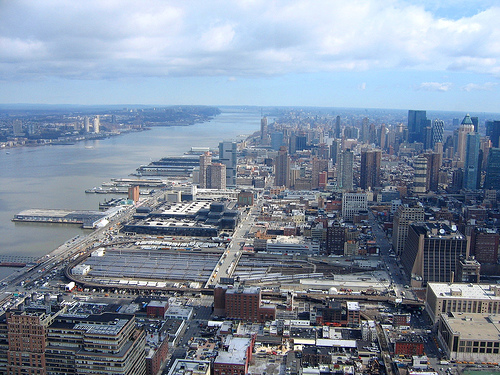Hard Cap on Hudson Yards Parking Takes Effect. Will More Reforms Follow?
 The Hudson Yards district on the Far West Side of Manhattan now has limits on off-street parking. Image: hotdogger13 via Flickr.
The Hudson Yards district on the Far West Side of Manhattan now has limits on off-street parking. Image: hotdogger13 via Flickr.Strict limits on the number of parking spaces that can be built on the far West Side of Manhattan are now in force, a year after the city settled a lawsuit over the issue brought by the Hell’s Kitchen Neighborhood Association. The new zoning amendment explicitly states that limiting off-street parking is an important component of building a pedestrian- and transit-oriented neighborhood, and it establishes a first-in-the-city program to track the number of parking spaces in the area.
The amendments put a "hard cap" on the total number of off-street parking spaces that can be built in the Hudson Yards special district: 6,905. "If a new developer comes in and says normally he’s entitled to have
300 parking spaces, if the cap has already been reached, he won’t be
able to build those spaces," said Christine Berthet, co-founder of
the Clinton/Hell’s Kitchen Pedestrian Safety Coalition. Before the lawsuit, the city was poised to allow as many as 17,500 new parking spaces in the area.
The lawsuit grew out of local opposition to the Bloomberg administration’s proposal to build a football stadium on the West Side of Manhattan. Sheldon Silver put an end to that particular idea but not the city’s plan to allow huge amounts of off-street parking in the Hudson Yards area. Plaintiffs took their claims to court in 2005, arguing that the plan violated limits on parking south of 60th Street, established in 1982 to keep the city in compliance with the Clean Air Act.
The adoption of the zoning amendment last week is an important acknowledgment that traffic can be mitigated by managing the supply of parking. And, on the 40th anniversary of the first Earth Day, it’s a timely reminder of the link between parking policy and environmental sustainability. "We filed this lawsuit because we knew what they were doing was violating the Clean Air Act," said Dan Gutman, an environmental planner and plaintiff in the Hudson Yards case. "Some people at City Planning thought they didn’t have to obey the rules anymore. Most people had forgotten that those rules existed."
In order to enforce the hard cap, the Department of City Planning will now track each and every off-street space in the area, roughly between Eighth and Eleventh Avenues and 30th and 43rd Streets. Counting those parking spaces will be a first for New York City. (San Francisco recently became the first American city to count all its publicly accessible parking spaces, information which will facilitate efforts to price parking more effectively.)
The changes will also prevent the City Planning Commission from granting special permits to build parking at Hudson Yards, a loophole that residents have consistently struggled against in Hell’s Kitchen. Developers have always been able to skirt the parking restrictions below 60th Street by obtaining special permits from the city. "The special permits have been given out as the industry asks," said Berthet. "There are very few examples of special permits that were turned down." Berthet sees the restrictions on special permits as "a huge win" and believes that the new language does not leave major loopholes open.
In addition, the amendment eliminates parking minimums and lowers parking maximums in the area. Developers who want to build less parking will have that option, while those who want to overload their site with spaces will be prohibited from doing so.
Overall, said Berthet, the zoning amendment is "a little more than was expected," in part because of language that the City Planning Commission added to original text. In the preamble, the amendment lays out the goal "to limit the amount of off-street parking… consistent with the objective of creating an area with a transit- and pedestrian-oriented neighborhood character." So, there is now a passage in city law that acknowledges the link between restricting off-street parking and building communities for pedestrians and transit riders.
The major question is whether this policy will affect areas outside the Hudson Yards special district. The planning department could extend the tighter control of special permits to the rest of Manhattan below 60th Street, for instance. Discussions with the city about pursuing that reform, however, seem to have lost momentum, said Gutman.
According to the Department of City Planning, a series of studies about parking policy in Manhattan are underway and any further recommendations will have to wait until they are completed. Whether the Hudson Yards rezoning signals a shift in planning department policy or a lawsuit-driven one-off remains to be seen.